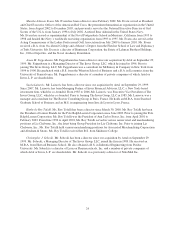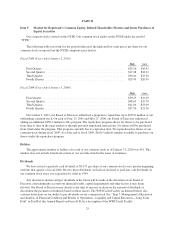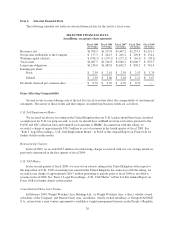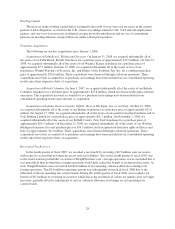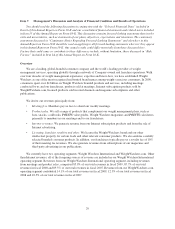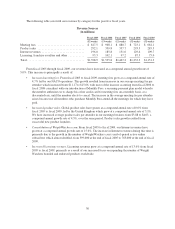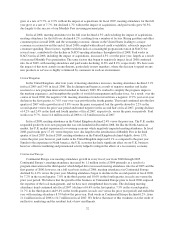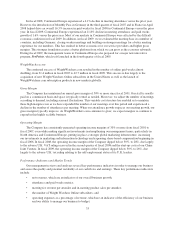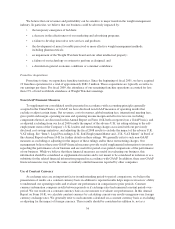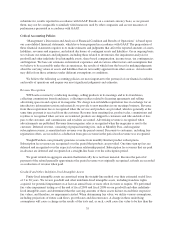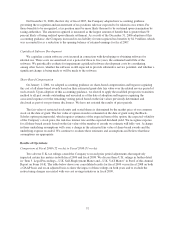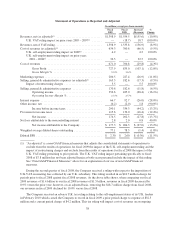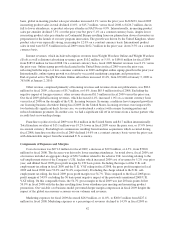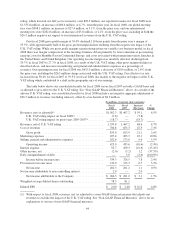WeightWatchers 2009 Annual Report Download - page 50
Download and view the complete annual report
Please find page 50 of the 2009 WeightWatchers annual report below. You can navigate through the pages in the report by either clicking on the pages listed below, or by using the keyword search tool below to find specific information within the annual report.We believe that our revenues and profitability can be sensitive to major trends in the weight management
industry. In particular, we believe that our business could be adversely impacted by:
• the temporary emergence of fad diets;
• a decrease in the effectiveness of our marketing and advertising programs;
• a failure to develop innovative new services and products;
• the development of more favorably perceived or more effective weight management methods,
including pharmaceuticals;
• an impairment of the Weight Watchers brand and our other intellectual property;
• a failure of our technology or systems to perform as designed; and
• a downturn in general economic conditions or consumer confidence.
Franchise Acquisitions
From time to time, we repurchase franchise territories. Since the beginning of fiscal 2001, we have acquired
19 franchise operations for a total of approximately $681.3 million. These acquisitions are typically accretive to
our earnings per share. For fiscal 2009, the attendance of our remaining franchise operations accounted for less
than 17% of total worldwide attendance at Weight Watchers meetings.
Non-GAAP Financial Measures
To supplement our consolidated results presented in accordance with accounting principles generally
accepted in the United States, or GAAP, we have disclosed non-GAAP measures of operating results that
exclude or adjust certain items. Net revenues, cost of revenues, global meeting fees, international meeting fees,
gross profit and margin, operating income and operating income margin and effective tax rate, including
components thereof, are discussed in this Annual Report on Form 10-K both as reported (on a GAAP basis), and
as adjusted excluding from our fiscal 2009 results the impact of the adverse U.K. tax ruling relating to the self-
employment status of the Company’s U.K. leaders and restructuring charges associated with our previously
disclosed cost savings initiatives, and adjusting the fiscal 2008 results to exclude the impact of the adverse U.K.
VAT ruling. See “Item 3. Legal Proceedings–U.K. Self-Employment Matter and –U.K. VAT Matter” in Part I of
this Annual Report on Form 10-K for further details on these rulings. We generally refer to such non-GAAP
measures as excluding or adjusting for the impact of these rulings and/or these restructuring charges. Our
management believes these non-GAAP financial measures provide useful supplemental information to investors
regarding the performance of our business and are useful for period-over-period comparisons of the performance
of our business. While we believe that these financial measures are useful in evaluating our business, this
information should be considered as supplemental in nature and is not meant to be considered in isolation or as a
substitute for the related financial information prepared in accordance with GAAP. In addition, these non-GAAP
financial measures may not be the same as similarly entitled measures reported by other companies.
Use of Constant Currency
As exchange rates are an important factor in understanding period-to-period comparisons, we believe the
presentation of results on a constant currency basis in addition to reported results helps improve investors’ ability
to understand our operating results and evaluate our performance in comparison to prior periods. Constant
currency information compares results between periods as if exchange rates had remained constant period-over-
period. We use results on a constant currency basis as one measure to evaluate our performance. In this Annual
Report on Form 10-K, we calculate constant currency by calculating current-year results using prior-year foreign
currency exchange rates. We generally refer to such amounts calculated on a constant currency basis as excluding
or adjusting for the impact of foreign currency. These results should be considered in addition to, not as a
34


